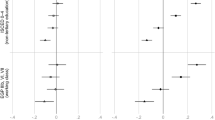Abstract
A socio-ecological approach to explain choice behaviour highlights salient personal and social factors in the context of changing aspirations and opportunities. The population databases are five cohorts of all school leaver applicants for university places in a state of Australia and a survey for one cohort. Results highlight common behaviour patterns across cohorts, with diverse outcomes for specific social groups. Offers of university places relate course preferences and school achievement. In addition, decisions to apply, accept and enrol vary with social experience by socio-economic indicators, geographic location and school type. Student explanations for their decisions to defer or let the offer lapse entail particular social factors as well as personal factors of self concepts, interests and financial needs. Findings contribute to a better understanding of choice behaviour, with a general model of the personal and social factors that explain diverse pathways to higher education.
Similar content being viewed by others
References
Ainley, J., Foreman, J., & Sheret, M. (1991). High school factors that influence students to remain in school. Journal of Educational Research, 85, 69–80.
ANTA Australian National Training Authority (1999). National report of the Australian vocational education and training system(Vol. 3). Brisbane: Australian National Training Authority.
Australian Bureau of Statistics (1998). Socio-economic index for areas. Canberra: ABS.
AVCC Australian Vice Chancellors Committee (1991). Unmet undergraduate student demand in higher education institutions. Canberra: AVCC.
Ball, S.J., Davies, J., David, J., & Reay, D. (2002). Decisions, differentiations and distinctions: towards a sociology of choice of higher education. British Journal of Sociology of Education, 23, 51–72.
Baumert, J. & Köller, O. (2000). National and international school performance studies: what can they do? What are their Limits? European Education, 32, 37–49.
Bornholt, L.J. (2000). Social and personal aspects of self knowledge: a balance of individuality and belonging, learning & instruction, 10, 415–429.
Bornholt, L.J. (2001). Self-concepts, usefulness and behavioural intentions in the social context of schooling. Educational Psychology, 21, 67–78.
Bornholt, L.J. & Möller, J. (2003). Attributions about achievement and intentions about further study in social context. Social Psychology of Education, 6, 217–231.
Bowes, J. & Hayes, A. (Eds.) (1999). Children, families and communities: contexts and consequences. Melbourne: Oxford University Press.
Brooks, R. (2002). 'Edinburgh, Exeter, East London or employment?': a review of research on young people's higher education choices, Educational Research, 44, 217–227.
Centre for Educational Research and Innovation (1998). Education policy analysis. Paris: Organisation for Economic Co-operation and Development.
DEET Department of Employment Education and Training (1993). National report on Australia's higher education sector. Canberra: AGPS.
Goldstein, H. (1997). Methods in school effectiveness research. School Effectiveness & School Improvement, 8, 369–395.
Hall, R. (2000). The first year experience at University. Sydney: Faculties of Arts and Social Sciences and Science and Technology, University of New South Wales.
Hesketh, B. (1998). Careers advice and tertiary decision-making 'downunder' in Australia. Journal of Vocational Behaviour, 52, 396–408.
Hoffman, L., Krapp, A., Renniger, K.A., & Baumert, J. (1998). Interest and learning. Proceedings of Seeon Conference on Interest and Gender. Kiel: Germany.
James, R. (2001). How school-leavers choose a preferred university course and possible effects on the quality of the school-university transition. Journal of Institutional Research, 78–88.
Jimenez, J. & Salas-Velasco, M. (2000). Modelling educational choices. A binomial logit model applied to higher education. Higher Education, 40, 293–311.
Long, M. (1992). Urban and rural participation, higher education series. Canberra: Department of Education, Employment and Training.
McDonald, R.P., Parker, P.M., & Ishizuka, T. (1993). A scale invariant treatment of recursive path models. Psychometrika, 58, 431–443.
MCEETYA Ministerial Council on Education, Employment, Training and Youth Affairs (2000). Task force on rural and remote education, training, employment and children's services: national framework for rural and remote education. Canberra: Australian Government Printing Service.
Need, A. & de Jong, U. (2001). Educational differentials in the Netherlands. Rationality & Society, 13, 71–98.
OECD Organisation for Economic Co-operation and Development (2001). OECD economic studies. Paris: OECD.
Oppenheimer, L. (1991). The concept of action: a historical perspective. In L. Oppenheimer & J. Valsiner (Eds.), The origins of action. Interdisciplinary and international perspectives. New York: Springer Verlag; pp. 1–36.
Parker, P.M., Bornholt, L.J., & Cooney, G.H. (1994). Transition from school to university in NSW. Report to the Australian Government Department of Education, Employment and Training. Canberra.
Paterson, L. (1992). The influence of opportunity on aspirations among prospective university entrants from Scottish schools, 1970-88. Journal of the Royal Statistical Society, 155, 37–60.
PMYPAPT Prime Ministers Youth Pathways Action Plan Taskforce (2001). Footprints to the future. Summary report of the Prime Minister's Youth Pathways Action Plan Taskforce. Canberra: AusInfo.
Reay, D. (2002). Class, authenticity and the transition to higher education for mature students. Sociological Review, 50, 398–418.
Reay, D., Davies, J., David, M., & Ball, S.J. (2001). Choices of degree or degrees of choice? Class, 'race' and the higher educations choice process. Sociology, 35, 855–874.
Robertson, C. (1993). Participation in post-compulsory education in Scotland. Journal of the Royal Statistical Society, 156, 423–442.
Robinson, R. (2004). Pathways to completion: patterns of progression through a university degree. Higher Education, 47, 1–20.
Valsiner, J. (1998). The guided mind. Massachusetts, USA: Harvard University Press.
Valsiner, L. & Lawrence, J.A. (1996). Human development in culture across the life span. In J.W. Berry & P.R. Dasen (Eds.), Handbook of cross-cultural psychology (Vol. 2): Basic processes and human development. pp. 71–106.
Williams T., Long, M., Carpenter, P., & Hayden, M. (1993). Entering higher education in the 1990s Department of Employment, Education and Training. AGPS, Canberra.
Author information
Authors and Affiliations
Corresponding author
Rights and permissions
About this article
Cite this article
Bornholt, L., Gientzotis, J. & Cooney, G. Understanding Choice Behaviours: Pathways from School to University with Changing Aspirations and Opportunities. Social Psychology of Education 7, 211–228 (2004). https://doi.org/10.1023/B:SPOE.0000018560.99580.2a
Issue Date:
DOI: https://doi.org/10.1023/B:SPOE.0000018560.99580.2a



